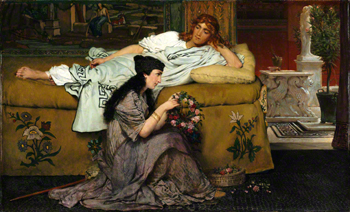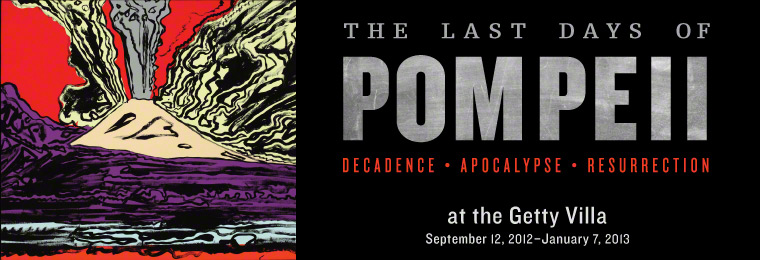Mount Vesuvius
 |
 |
The eruption of Mount Vesuvius in 79AD destroyed the nearby towns of Pompeii and Herculaneum.
|
http://history-magazine.com/volcanoes.html
Getty Villa is currently showing an exhibit of 74 art pieces and sculptures inspired by archeological objects found in Pompeii from the imagination of artists and filmmakers.
There is a link below to the list of 74 exhibited items and you will see works by artists from various European countries including Salvador Dali to Andy Warhol, Robert Rauschenberg, Mark Rothko and photos of Pompeii taken during the Second World War.
For a preview (or if you are not in Los Angeles), see some of the paintings here:
http://www.arttattler.com/archivepompeii.html
One of the best essays on this exhibit is by Gail Leggio and you can read the rest of the essay by clicking on this link: http://www.nccsc.net/essays/pompeii-and-historical-imagination
Pompeii and the Historical Imagination
 Sebastian Pether
Sebastian PetherEruption of Vesuvius with Destruction of a Roman City, 1824
Museum of Fine Arts, Boston
When we think about the ancient world, how do we visualize it? Written accounts—those that have come down to us from antiquity and those produced by generations of later historians—lay a foundation for understanding. Physical evidence gives us a more concrete sense of life in the past, of the ancients’ high aspirations, seen in the artworks we find in museums, and of their civic experience, glimpsed in the artifacts and layouts of archaeological sites. But turning data into history inevitably entails interpretation, and historical interpretation, while it must be based in fact, also requires imagination. Here another category comes into play: historical fictions. At their most vivid, these re-creations—paintings, novels and movies—shape how we picture the past in persuasive and powerful ways. The posthumous life of antiquity in works of the imagination is a rich subject, which the Getty Villa, in Malibu, California, is exploring in “The Last Days of Pompeii: Decadence, Apocalypse, Resurrection” (September 12, 2012–January 7, 2013). Co-organized by the J. Paul Getty Museum and the Cleveland Museum of Art, in association with the Musée national des beaux-arts du Québec, the exhibition traces the influence of Pompeii on artists from Giovanni Battista and Francesco Piranesi to Andy Warhol.
This Getty blog provide more details behind this exhibit:
http://blogs.getty.edu/iris/apocalypse-then-bulwer-lyttons-the-last-days-of-pompeii/
You can even read the entire novel which is mentioned in this exhibit:
Last Days of Pompeii by Baron Edward Bulwer Lytton Lytton
by downloading from:http://gutenberg.org/ebooks/1565
What I learned today (after the visit) is that there is also a book called "Three Hours in Pompeii" which is a guidebook to all the places and locations mentioned in the first book. It can also be downloaded for a really good project-based study and this would be really fun to have if one ever goes to see Pompeii after reading both books.
Three hours in Pompeii; a real and practical guide-book compiled in harmony with the description given by Bulwer Lytton in his work entitled "The last days of Pompeii" (1907)
Finally, if you wish to learn more about Pompeii tombs, here's a podcast:
http://classics.uc.edu/index.php/podcasts/169-pompeii-podcasts-the-tombs-of-pompeii
UC Classics graduate student Allison Emmerson shares her expertise on Pompeii’s tombs. She explains ways in which monuments commemorating individuals, their families, their slaves, and former slaves can offer insights into how people lived and what they valued. While these tombs are an important part of the site for studying the dead, they also played a prominent role in the living city, serving as places to stop and sit, write graffiti, and even deposit trash.
Enjoy the exhibit! More from the website of Getty Villa:
The Last Days of Pompeii addresses the potent legacy of the ancient city of Pompeii in the modern imagination.

Glaucus and Nydia, 1867, Lawrence Alma-Tadema. Oil on wood panel, 15 3/8 x 25 5/16 in. (39 x 64.3 cm). The Cleveland Museum of Art, Gift of Mr. and Mrs. Noah L. Butkin, 1977.128
Exhibition Checklist
The eruption of Mount Vesuvius in A.D. 79 destroyed yet paradoxically preserved the city of Pompeii and neighboring towns. Seemingly frozen in time, they are often considered the places where we can best access the daily lives of ancient Romans. While providing windows to the past, since their rediscovery in the early 1700s, the Vesuvian cities have also served as mirrors of the shifting present. For three centuries they have remained a constant obsession, inspiring foremost artists—from Piranesi, Fragonard, Ingres, and Alma-Tadema to Duchamp, Dalí, Rothko, and Warhol—to examine contemporary concerns, such as sexual identity, psychoanalysis, the nuclear threat, collective memory, and the nature of art.
The exhibition draws its name from Edward Bulwer-Lytton's 1834 novel The Last Days of Pompeii, a melodrama of Pompeian life set immediately before the eruption of Vesuvius. One of the most popular literary works of the 19th century, the novel transformed modern perceptions of Pompeii and inspired numerous works of art, several of which are on view in the exhibition.
The exhibition draws its name from Edward Bulwer-Lytton's 1834 novel The Last Days of Pompeii, a melodrama of Pompeian life set immediately before the eruption of Vesuvius. One of the most popular literary works of the 19th century, the novel transformed modern perceptions of Pompeii and inspired numerous works of art, several of which are on view in the exhibition.
http://www.getty.edu/art/exhibitions/pompeii/index.html
UPDATE after seeing the exhibit:
Yes, the exhibit is really very comprehensive and definitely worth seeing --- from paintings, sculptures, films, to photographs, images of Pompeii is imagined from the only two contemporary accounts of the 79 AD eruption by Pliny the Younger and from the novel "Three Days in Pompeii" and from the 1903 novella "Gradiva" by Wilhelm Jensen. Photographs are not permitted in this entire exhibit, and if you are not able to come to Los Angeles or see it in Cleveland, I would suggest taking a look at photos and texts about the photos of the exhibited items in the book published in conjunction with this exhibit:
http://books.google.com/books?id=zu6kmWWNQg0C&pg=PA116&lpg=PA116&dq=dali+and+Pompeii&source=bl&ots=f1D9_kIMH8&sig=MKEwrAI9ZCkaURYR3Sn2YSVAOV0&hl=en&sa=X&ei=__ShUOutKezOigLtjoGQCw&ved=0CF8Q6AEwCA#v=onepage&q&f=false
I have not been a big fan of Salvador Dali, but his painting seen here on page 117 and described in context of his life on page 116 is absolutely hauntingly beautiful and poignant using only a few colors. It is single most symbolically rich painting in the exhibit and probably the only one without any fiery red in it.
Don't forget to get the audioguide ipod for Getty which has many segments on the Pompeii exhibit. Free with photo-ID, but on the first come, first served basis.

No comments:
Post a Comment